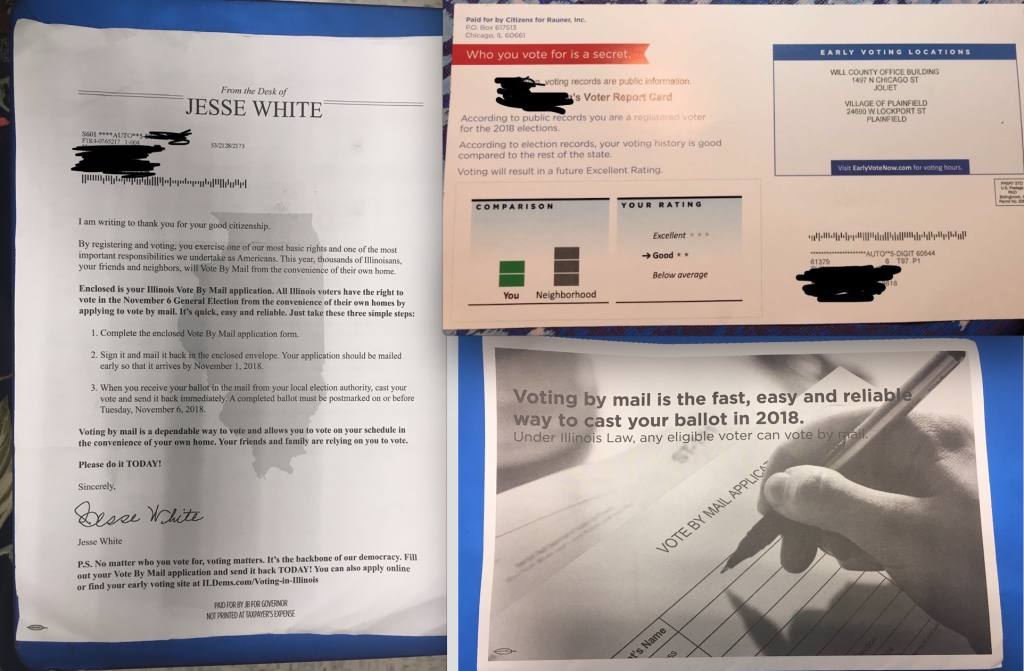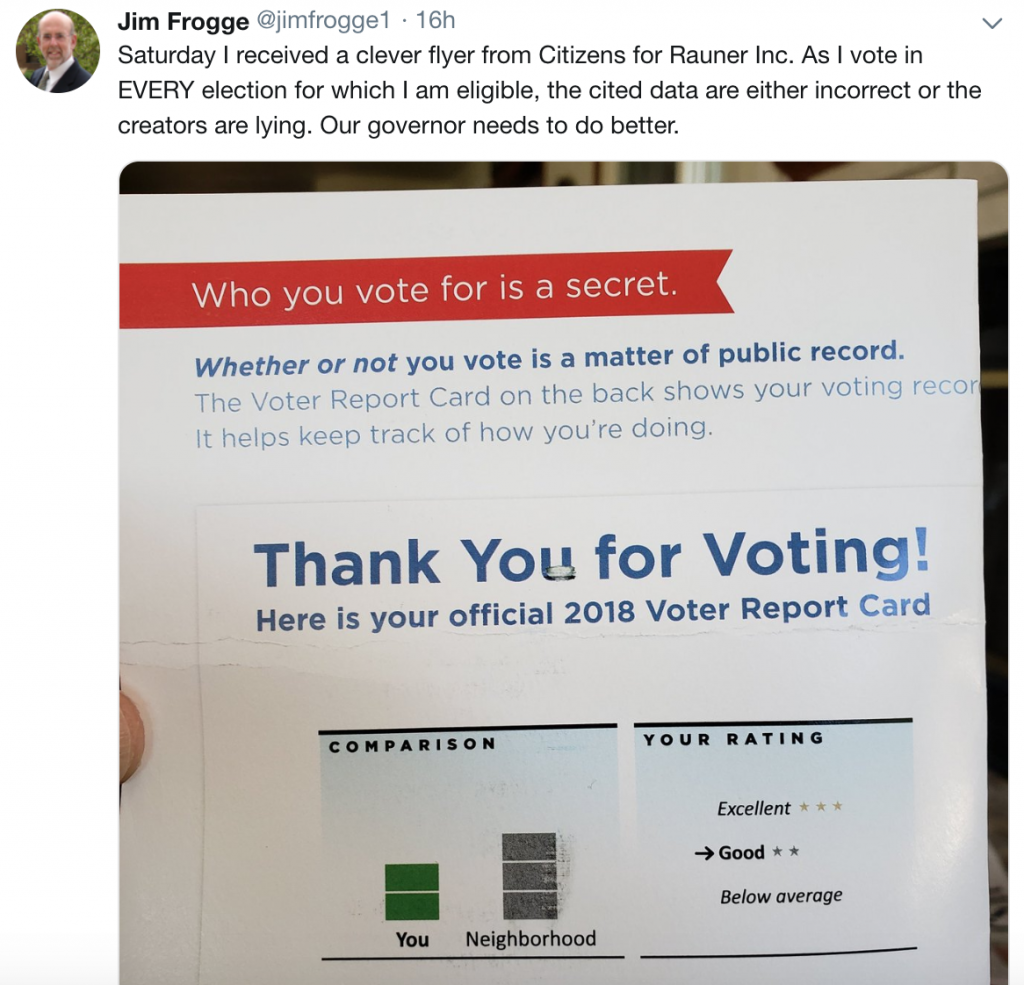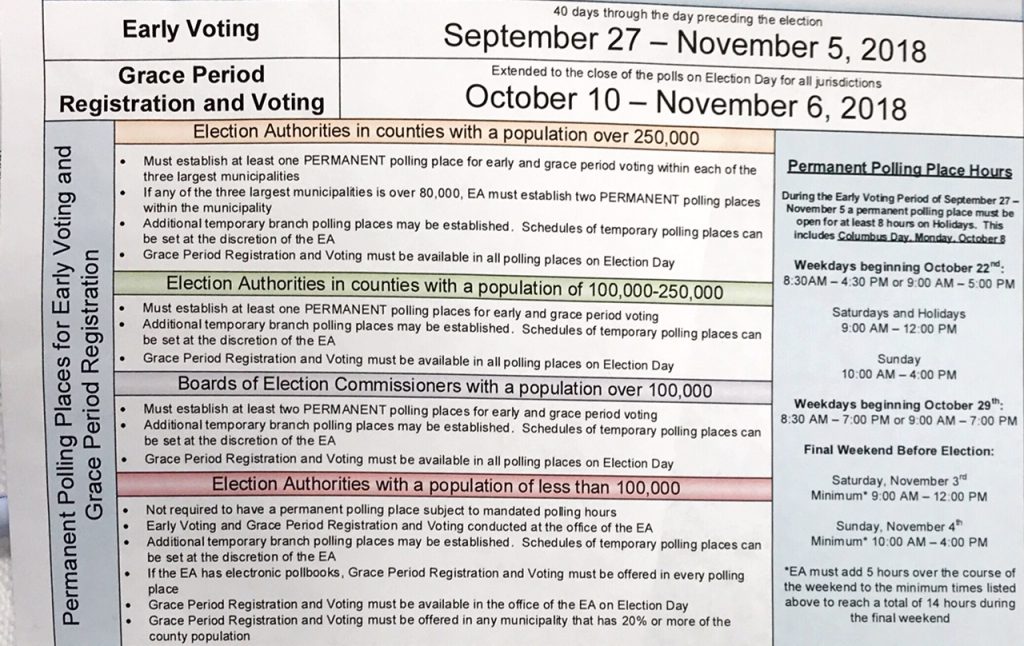-
Mailers sent by Rauner, Pritzker pull out all the stops to urge voters to cast an early ballot
 Three different voter contacts on early voting from the campaigns of both Democrat JB Pritzker and Gov. Bruce Rauner.
Three different voter contacts on early voting from the campaigns of both Democrat JB Pritzker and Gov. Bruce Rauner.
Likely Republican voters around the state looked into their mailboxes over the weekend to find mailers rating them on their past election participation as compared with others in their neighborhood.
A mailer sent to a registered Republican in Plainfield, obtained by The Daily Line, rates the voter’s participation record as “good” and advises that voting next week “will result in a future Excellent Rating.”
The mailer, paid for by Gov. Bruce Rauner’s campaign, also gives two suggestions for early voting locations and encourages the recipient to check EarlyVoteNow.com — which redirects to a section of the governor’s campaign website — to find voting hours at the recommended early polling places.
Rauner’s mailer is a toned-down version of so-called voter shaming mailers that have become more popular in recent years, including a mailer that went out in the days before the March primary sent to Chicago-area voters by the mystery group Illinois State Voter Project. Those mailers named voters’ neighbors and showed whether or not they had voted in the previous three elections in an attempt to pressure voters to get to the polls.
[gallery columns="2" size="full" ids="62206,62205">
Illinois State Board of Elections spokesman Matt Dietrich said the agency heard plenty from voters this spring who were unhappy with the mailers.
“We were inundated with calls about that in the week before the March 20 Primary,” Dietrich said. “It is a legitimate use [of voter data] but we can tell from the reaction that it does definitely get people’s ire up.”
The governor’s recent mailers only vaguely refer to a voter’s record as compared with his or her “neighborhood.”
Rauner campaign spokesman Alex Browning said the mailers went out to voters “statewide,” but declined to say how many were sent or how much the campaign spent on the effort.
One Kankakee-area voter took to Twitter to complain about his election participation rating. Jim Frogge, whose Twitter account identifies himself as a former teacher at Bishop McNamara Catholic High School tweeted Monday that the mailer was “clever,” but was disappointed in the conclusion.
“As I vote in EVERY election for which I am eligible, the cited data are either incorrect or the creators are lying,” Frogge tweeted. “Our governor needs to do better.” A Twitter user complains about Gov. Bruce Rauner's new mailer on Monday.
A Twitter user complains about Gov. Bruce Rauner's new mailer on Monday.
Frogge did not return messages left by The Daily Line Monday.
But Rauner’s mailers are only the latest efforts in this campaign season’s get-out-the-vote drive — a push marked this year by its focus on early voters.
Rauner’s challenger, Democrat JB Pritzker, made a show of casting his ballot a full 40 days before Election Day on Sept. 27, the first day polls were open for Illinois’ early voting period. Pritzker made his selections at the Chicago Board of Elections’ Loop Super Site — one of hundreds of early voting locations across the state.
Early voting requirements vary by the population served by a local election authority, according to the State Board of Elections.Pritzker’s campaign has promoted early voting on social media, producing two videos encouraging voters to cast their ballots early in the General Election, following up from a similar push before the Primary. The campaign is also sending voters to a website funded by the Democratic National Committee to find his or her early polling place. Early voting guidelines for local election authorities of varying sizes. [Courtesy of the State Board of Elections]
Early voting guidelines for local election authorities of varying sizes. [Courtesy of the State Board of Elections]
Rauner too has encouraged supporters via social media to vote early or cast their ballots by mail, but the effort hasn’t been as big as Pritzker’s. Observers noted that it’s not surprising that Rauner has let Pritzker take the lead on more nonpartisan informational get-out-the-vote efforts, as Pritzker is a member of the majority party in Illinois.
Illinois’ experiment with early voting began in 2006, and has now been expanded to more than five weeks’ worth of opportunities for early voting, both in person and by mail. The state’s more recent pilot programs for online, grace period and same-day voter registrations have also been made permanent, and campaigns are beginning to use the extra time to make more unique voter contacts.
In the weeks before Pritzker cast his ballot last month, his campaign had sent two rounds of vote-by-mail applications to 2.5 million likely voters around Illinois, the campaign said. Campaign finance records show the Pritzker campaign paid $1.2 million to Chicago-based firm The Strategy Group, Inc. for the first round of applications, which went out in early September, and spent an additional $1 million on the second round of mailings, which were sent later in the month.
[gallery size="full" ids="62209,62207,62208">
Rauner is not doing a vote-by-mail application drive this campaign cycle, breaking tradition from the last few general elections when the gubernatorial candidates from both parties had done so. Though Republicans had been pioneers in vote-by-mail applications in Illinois, The Daily Line was told, observers said Rauner’s calculations to use his resources elsewhere could be a shrewd move.
Though local election authorities don’t keep track of which vote-by-mail applications come in through specific channels like the Pritzker campaign, the campaign can still keep track via information provided by the U.S. Postal Service. The applications sent out to likely voters also had pre-paid return envelopes, which allows the Pritzker campaign to keep a running tally of how many vote-by-mail applications the Democrat has spurred.
The Pritzker campaign told The Daily Line on Monday that the latest numbers indicate 200,000 of the 450,000 vote-by-mail applications originated from Pritzker’s mailings.
The State Board of Elections’ total number of vote-by-mail applications differed Monday; the agency’s latest figures show 519,276 applications have been requested.
The first of Pritzker’s vote-by-mail applications came in an envelope bearing the name of Illinois Secretary of State Jesse White, but also clearly indicated it was paid for by the Pritzker campaign.
Inside, along with the vote-by-mail application, was a letter with instructions on how to fill out the application, signed by White with “From the Desk of Jesse White” at the top of the letter. The bottom of the letter clearly states the mailing was paid for by Pritzker’s campaign, and “not printed at taxpayer’s expense.”
Though Dietrich said the Board of Elections doesn’t cast any official judgment on get-out-the-vote efforts like this, as they’re perfectly legal, he did say the agency received “numerous calls” about the mailers.
“I can say, though, that used on the reaction we got, there are voters who were confused and some were a bit angry about it,” Dietrich said.
Pritzker deputy spokesman Jason Rubin told The Daily Line on Monday that the campaign enlisted White for the vote-by-mail application push as he is a “trusted leader.”
“JB and [lieutenant governor candidate] Juliana [Stratton] are running a statewide operation to get out the vote for Democrats up and down the ballot in this election,” Rubin said. “JB and Juliana are committed to protecting and expanding the right to vote and encouraging turnout and have invested in programs to ensure all Illinoisans can make their voices heard in this critical election.”
White’s spokesman for his governmental office, Dave Druker, said the office was advised about White’s name being used for Pritzker’s campaign in this capacity, but hadn’t received any calls from voters about it.
Elections officials told The Daily Line that the use of White’s name was far less egregious than a 2016 vote-by-mail application drive that used an altered state seal to attract voters’ attention.
Another change for 2018 is a tweak to state law that stipulates vote-by-mail applications must be labeled with a return address of a voter’s local election authority, not the campaign that originated the application.
Chicago Board of Elections spokesman Jim Allen said the new procedure has made the process run “more smoothly” than in past years, like in 2014 when both former Gov. Pat Quinn and then-candidate Rauner both had vote-by-mail application drives.
“This is much better than four years ago when both Rauner and Quinn were mailing them out and having them come back to themselves,” Allen said. “This is far better…what was happening was we were having delays [before the new law].”
The law was passed as part of an omnibus elections bill this spring, a year and a half after a Rock Island County clerk discovered 1,500 absentee ballot requests in a post office box that had gone unchecked until late October 2016. The post office box turned out to have been authorized by the Illinois Opportunity Project, an independent expenditure group founded by conservative radio host and donor Dan Proft.
Allen also acknowledged that Pritzker’s double vote-by-mail applications may have confused some voters, but said that anyone who sent in two applications for a mail-in ballot were immediately recognized by the system.
Voting by mail has become increasingly popular in recent years, and while Illinois’ laws on voting by mail place it in the middle of the pack on the issue, according to the National Vote at Home Institute, the state has made strides.
Gerry Langeler of the institute told The Daily Line on Monday that Illinois has made a “huge step up” from 2014, when approximately 40,000 voters — a little over half a percent of those registered — received a ballot in the mail. Langeler said Illinois is on track to have close to 7 percent of its voters cast a ballot by mail.
Related: Elections officials explore vote by mail programs to increase turnout, security
Some states like Washington, Oregon and Colorado have adopted laws that mandate each registered voter receives an absentee ballot in the mail. Some voters will opt to go to the polls instead, but Langeler said the option is becoming more and more popular. Nearly every county in Utah is now vote-by-mail focused, he said.
Langeler said one of the reasons he believes his organization’s data is predicting 42 million vote-by-mail ballots nationwide this year is the electorate’s growing demand for convenience in other areas of their lives.
“People who have busy lives are are figuring out it’s a whole lot easier to fill out ballot at kitchen table than [waiting for Election Day],” he said. “We increasingly don’t wait in lines. We shop online, we bank online, we buy concert tickets online.”
Langeler also acknowledged that factors like transportation and childcare also have played a role in pushing for vote-by-mail programs.
But national parties have also led the charge for early voting in states where it’s a possibility, whether by mail or in person, Langeler said, in part because of the “growing number of unaffiliated voters.” When parties can push for their own voters to cast ballots early, they have more time to focus on those undecided voters whose ballots they covet.
“Parties really want to make sure they’re getting their designated folks out because there’s this huge wildcard of unaffiliated voters and they don’t know [how they’ll vote],” Langeler said.
As of Monday, 382,910 Illinoisans have voted early in person, plus 211,354 more who have mailed in completed ballots, according to the State Board of Elections. According to ElectProject.org, a website maintained by University of Florida Associate Professor Michael McDonald, early votes cast in Illinois are now at 77 percent of the total number of early votes cast in 2014, with one week left to go until Election Day.
As for Rauner?
“He plans to vote on Election Day,” Browning said.
Do you like this page?














